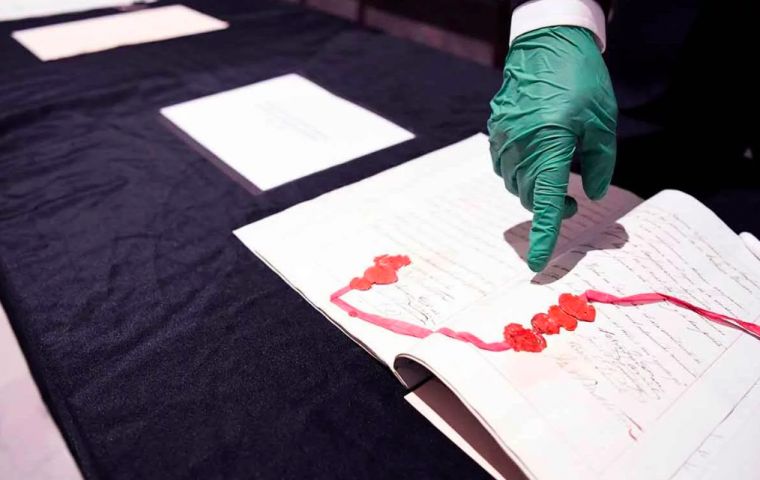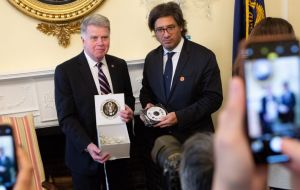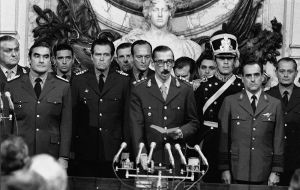MercoPress. South Atlantic News Agency
Declassified U.S. Documents Reveal Details About Argentina’s Dictatorship
 Representatives of the ultra-secret directorate, which included intelligence officers from Chile and Uruguay, settled on their next victim through a “majority vote.”
Representatives of the ultra-secret directorate, which included intelligence officers from Chile and Uruguay, settled on their next victim through a “majority vote.”  The newly declassified US government documents shed new light on the repressive tactics of military regimes in South America and on US awareness of their actions
The newly declassified US government documents shed new light on the repressive tactics of military regimes in South America and on US awareness of their actions  Latin American military officials received training on harsh counterinsurgency techniques at the US Army School of the Americas
Latin American military officials received training on harsh counterinsurgency techniques at the US Army School of the Americas The assassination squad created by Argentina’s military dictatorship to target dissidents during the 1970s had, like other state programs, its own bureaucratic rules: Employees punched in at 9:30 a.m. and were entitled to a two-hour lunch. They received a US$ 1,000 clothing allowance during their first overseas mission. And they were required to submit expense reports.
Representatives of the ultra-secret directorate, which included intelligence officers from Chile and Uruguay, settled on their next victim through a “majority vote.”
These details of the assassination program, which pursued enemies in the region and in Europe as part of the Cold War intelligence alliance known as Operación Cóndor, have been found in a 1977 CIA report, part of a trove of newly declassified United States government documents that shed new light on the repressive tactics of military regimes in South America and on American awareness of their actions.
The exchange of over 7,500 records — which the United States formally delivered to the Argentine government on Friday as part of a deal struck during the final months of the Obama administration — is one of the largest transfers of declassified documents from one government to another.
The records contain many new insights, such as confirmation that dozens of people who disappeared at the time were assassinated at the hands of the state. Prosecutors and human rights activists in Argentina are hopeful that the newly available records will aid continuing prosecutions. More than 1,500 former officials in the country have been put on trial for crimes including torture, thousands of forced disappearances and executions and the abduction of hundreds of babies.
The information will vastly enhance the public record of a grim era, said Carlos Osorio, the director of the Southern Cone Documentation Project at George Washington University’s National Security Archive.
“The amount of information the intelligence agencies had sends shivers through one’s spine,” he said. “Imagine what it meant to know about atrocities in real time.”
The United States provided varying degrees of support to military juntas that came to power in Latin America during the Cold War. Latin American military officials received training on harsh counterinsurgency techniques at the United States Army School of the Americas as Washington leaned on allied governments to stem the appeal of communism in the region.
Officials also shared information with military dictatorships that resulted in the detention, torture and in some instances killing American citizens, according to these records and separate court findings.
The newly released documents also suggest that some senior American intelligence officials grew unnerved by the brutality of the regimes the United States backed during that era, particularly when they learned about plans to carry out assassinations in European countries.
Operation Condor
In a 24 July 1976 memorandum, Raymond A. Warren, the C.I.A.’s Latin America division chief, warned a supervisor that the assassination task force’s plans to “liquidate” suspected leftist militants abroad “poses new problems for the agency” and should prompt a debate about what actions the United States could take to “forestall illegal activity of this sort.”
Mr. Warren wrote that “every precaution must be taken to ensure that the agency is not wrongfully accused of being a party to this type of activity.”The time-consuming declassification review process was ordered in March 2016 as part of the Obama administration’s quest to set a new tone in Washington’s relationship with Latin America.
“There was a desire to look at past actions on our part in Latin America with openness and a willingness to confront darker chapters of our policy,” said Benjamin Gedan, a former Obama White House official who worked on Latin America policy.
Gedan said he was surprised the Trump administration did not scrap the process, since it has taken a radically different approach toward Latin America, endorsing the Monroe Doctrine, which takes an interventionist view of the hemisphere.
The newly released cache includes an FBI report about the execution of Marcos Osatinsky, a prominent leader of the Montoneros, an armed leftist movement that fought Argentina’s dictatorship. American officials learned that Argentine officials brutally tortured and killed Mr. Osatinsky, lied about the circumstances under which he died and disposed of the body before an autopsy could be conducted.
“The purpose of stealing his body was to prevent the body from being subjected to an autopsy, which would have clearly shown he had been tortured,” F.B.I. agent Robert S. Scherrer wrote. “It is doubtful that Osatinsky’s body will ever turn up.”
The documents also disclosed new facts about the abduction and assassination of Jesús Cejas Arias and Crescencio Nicomedes Galañena Hernández, two employees of the Cuban Embassy in Buenos Aires, who vanished on Aug. 9, 1976. The Associated Press received an envelope that included the credentials of one of the men along with a note saying they had deserted “to enjoy the freedoms of the Western world.”
However, American officials soon learned that the Cubans were bundled into an ambulance as they were leaving work and sent to a notorious detention center operating our of a car mechanic shop, where they were tortured for 48 hours. Their bodies were later dumped in the Paraná River, according to a C.I.A. report.
The agency also learned that the mysterious assassination of Hector Hidalgo Sola, Argentina’s ambassador to Venezuela, which occurred in Buenos Aires in July 1977, was a rogue operation by Argentine intelligence agents who were seeking to extort the diplomat’s family for money.
The records offer new facts about American citizens who were detained and tortured in Argentina, including Gwen Bottoli, who was taken into custody in April 1976 after leaving banned political pamphlets on a bus stop bench in Rosario.
F.B.I. records show Ms. Bottoli had been under investigation by American law enforcement officials for her activism in the Socialist Youth Alliance. A United States document about her activities, written in Spanish, suggests American officials may have shared their concerns about the group with the Argentines before her arrest, according to Mr. Osorio.
In a phone interview from her home in Minnesota, Ms. Bottoli recalled being smacked across the face during her initial interrogation. She was then led to a room where she was blindfolded, undressed and shocked with an electric prod as her captors asked about associates.
“I was really afraid I would be dismembered and go through further pain,” Ms. Bottoli, 77, said.
Ms. Bottoli said she saw the declassification process as a positive step. “I appreciate that I may have a chance to tell my story so that we don’t allow history to repeat itself,” she said.
Argentina has done more than its neighbors to investigate abuses committed by the state during the dictatorship, which lasted from 1976 to 1983.
María Ángeles Ramos, an Argentine federal prosecutor who oversees the department handling crimes against humanity, said earlier records declassified by the United States have been valuable in corroborating evidence and identifying new culprits. With about 40% of cases still awaiting judgment, she said her team has high hopes the latest batch of records will advance their work.
“These documents will undoubtedly help answer a lot of questions that are still pending,” Ms. Ramos said. “This will continue to bring truth to the victims.”
President Mauricio Macri of Argentina, who is regarded with disdain by many human rights activists focusing on the dictatorship era, expressed hope recently that the new documents will bring more victims a measure of justice.
“They will be essential for there to be justice in past cases, still pending, from one of the darkest periods of Argentina’s history,” he said last month
The release comes amid a raging debate in neighboring Brazil about its own period of military rule. President Jair Bolsonaro, a far-right politician who served in the Army early in his life, last month called on the armed forces to commemorate the 1964 coup that installed a repressive military dictatorship for 21 years.
Peter Kornbluh, a senior analyst at the National Security Archive, argued that declassifying documents earlier than the government ordinarily would makes a meaningful contribution.
“These documents remind us of the ugly reality of the military coups and the regimes that followed,” he said. Access to them is “the strongest bulwark against the reactionary revisionism that is attempting to paint a pretty picture of the military regimes in the southern cone.”
By Ernesto Londoño for The New York Times




Top Comments
Disclaimer & comment rules-

-

-

Read all commentsThat is correct. If we interfere in your politics you castigate us and if we don't you castigate us. So we sit on the fence and let you ( the Argentine populace ) deal with it
Apr 15th, 2019 - 11:53 am +1So this confirms what we had lost suspected - that the US government knew about these gross human rights abuses in Argentina but that they did absolutely nothing to stop them. This appalling complicity confirms the reality of the much-maligned term 'imperialism' to characterise the relations between the US and Argentina and Latin America.in general.
Apr 15th, 2019 - 10:59 am 0@Pytangua
Apr 16th, 2019 - 01:25 am 0Absolutely. Not only the US government knew about the abuses; they have traditionally trained Latin American armed forces members on anti-subversion strategies, and of course, interrogation techniques.
The US was doing it under the Monroe doctrine, assuming they had full rights to prevent the emergence of any Latin American government slightly to the left of what they liked which was nothing less than the most extreme backward right.
Those kidnapped during the 1976-1983 dictatorship in Argentina knew their captors could interrogate and torture them for days, weeks or months, since they were disappeared and no authority, be it police, the army or any other security force -- would acknowledge their detention.
In this way, thousands of men, women, teenagers or elderly were kept in filthy conditions in makeshift clandestine prisons, repeatedly taken to torture sessions until the day they were injected a powerful sedative, loaded into planes and dumped alive to the sea.
All of that, of course, was done in the name of “decency,” religion and “order.”
Commenting for this story is now closed.
If you have a Facebook account, become a fan and comment on our Facebook Page!